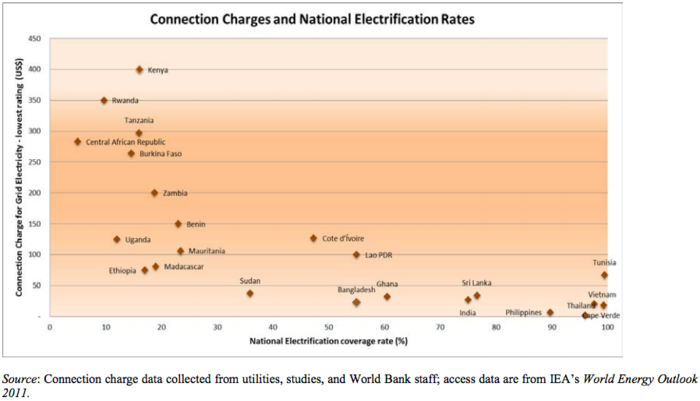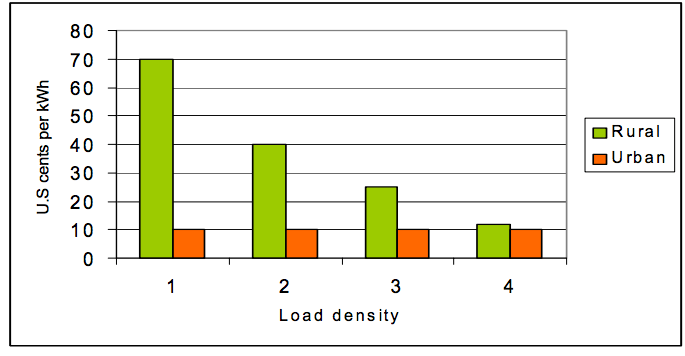Knowledge fuels change
For over a decade, Energypedia has shared free, reliable energy expertise with the world.
We’re now facing a serious funding gap.
Help keep this platform alive — your donation, big or small, truly matters!
Thank you for your support
Affordability of Grid Electricity
Introduction
Lack of energy access continues to be a pervasive issue in many countries. A contributing factor to this is the unaffordability of grid electricity. Many countries have yet to achieve 100% electrification of their population, with electrification rates as low as 31.1% in Cambodia, to 6.4% in Niger.[1]
Low electrification rates are coupled with high connection costs[2],as can be seen by the data in Figure 1. In Sub-Saharan Africa, a region with one of the lowest electrification rates world-wide, industrial electricity tariffs can reach $20-50 cents/kWh[3]. Compared to a global average electricity tariff of $10 cents/kWh[4], this is very high. Such high tariffs in regions with limited electrification rates result from the high costs for domestic connection, as well as from high investment costs coupled with low profitability. Therefore, the few generators and suppliers that do sell electricity are only able to sell it for higher prices.
Figure 1: Relationship between connection charges and electrification (Golumbeanu and Barnes, 2013)[2]
In Asia, the Philippines has among the highest residential electricity tariffs[5] due to a lack of government subsidies. This has limited the access to the commodity from lower-income households. As revealed by several studies, it is the poor who are more likely to have no access to power, consequently remaining in poverty due to being unconnected.[4] Affordable access to electricity is necessary in order to ensure economic growth. As such, electrification is seen as a way to encourage “pro-poor growth”[6].
Financing: The Cost of Making Electricity Affordable
Making electricity affordable may involve many different actions: policy changes, system optimization, and subsidies among others. The World Bank defines affordable electricity as 30 kWh of electricity that costs no more than 5% of a household’s income[7]. This amount would be easily covered by subsidies. Estimates show that in Africa, this cost should not exceed 6% of utilities’ current income. For 19 countries, this would cost less than $5 million in annual subsidies and can be as low as $1 million for majority for the same countries. However, this excludes rural communities and assumes these will be served by off-grid setups. Off-grid electricity production can come in many forms, therefore its costs are more difficult to quantify.
Household Costs of Grid Connections
Many countries remain unable to offer grid connection at low cost. As shown in figure 2, where the density of demand is rather low, the cost of connecting to the grid is high.[8] This supports the notion that grid expansion in sparsely populated communities is expensive, and therefore less profitable. Rural households have to pay higher prices to become connected.
Figure 2: Load density vs. grid connection cost (Steve Fisher/Practical Action, 2007)[8]
The data in figure 2 shows the negative correlation between load density and grid-connection charges. These charges are so high that it is common for two African households to share one meter. In Ethiopia, the minimum charge available comes as 130% of the average monthly income of a household. Tariff structures are largely affordable for many users, but the high connection charges mean households have to share meters. As a result, grid-connected households outnumber meters 2 to 1. However, sharing a meter can also prove to bring disadvantages, as the raised consumption can place the meter on a higher tariff bracket due to increasing block tariffs[7], thus effectively making the electricity, used by the households, more expensive.
Even when connected, the 33% of Africans who do have access to electricity suffer from highly interruptible supply. Some countries offer lifeline rates as an alternative, which essentially allow discounted electricity usage to a certain amount, then start charging use. Whilst this mechanism widens electrification reach, when coupled with increasing block tariffs, this can stifle positive activities such as studying and/or limit income-generating activities. This does little to help low-income households to escape poverty.
Measures for Achieving Affordable Electricity
In the study “Making power affordable for Africa and viable for its utilities” (2016), the World Bank suggests several solutions that address the problems of consumers:[7]
- Prepaid electricity: Current tariff structures assume that consumers always need electricity. For a low-income household, this is often not the case as income dictates their capability to use electricity. By providing prepaid connections, use is matched with income.
- Optimization and increased efficiency: By optimizing the entire system, operating expenditure is reduced and a more reliable supply is made available. This could potentially stretch the grid due to savings made from efficiency measures.
- This can be done through accurate metering and billing, or increased machine efficiency among other methods.
- Lowered connection charges and tailored tariff blocks: As the primary cost, utilities should lower these charges to enable more consumers the access. Additionally, a moving average should be the basis for lifeline tariffs to better reflect consumer usage.
- Load Limited supply: To lessen the cost of grid expansions, electricity can be supplied for limited loads[9]. With lower load factors, systems will be less costly. This however means that the maximum load must be low, limiting consumer-end use. Other measures target the financial viability of affordable electricity which is critical to operate efficiently and to obtain the necessary investments.[7] [9]
- Raised tariffs: The World Bank’s study revealed that eliminating inefficiencies alone would be unable to widen electricity access. Therefore, tariffs must be increased to allow utilities to expand their reach.
- This measure should be coupled by consumer conscious details such as incremental tariff increases, and targeting larger and better-off consumers. It is best coupled with supply improvements to guarantee price acceptability.
- Cost reductions and increased cash collections: transmission & distribution and collection losses combined represent the dominant hidden cost in 18 countries, indicating that current tariffs might be sufficient to cover costs over the medium term.
- While many policy makers focus on raising tariffs, it may make sense to focus more on cost reductions via investments in transmission & distribution and increased cash collections. Subsidies should be targeted and not merely cover operational inefficiency costs. Those lower the incentives to improve utilities’ performance and tend to grow disproportionately.[9]
Trends in status of financial viability in Sub-Saharan Africa (SSA):[9]
- Only the Seychelles and Uganda have financially viable electricity sector (only 2 out of 39 countries in SSA). Quasi-fiscal deficits average 1.5% of GDP, and exceed 5% of GDP in several countries.
- Ethiopia implemented a state funding for capital expansion program.
- Tanzania increased tariffs, reduced transportation and distribution losses, and thus managed to lower quasi fiscal deficits in 2014.
- In Nigeria, the deficit was very large in the early 2000ies but power sector reforms and privatization lowered it.
- Most countries have improved or maintained performance, and relatively few countries have had declining financial viability. (In Botswana, the deficit has increased due to delays in the commissioning of new power plants.)
Further Information
- Grid- External Links
- Electrifying_Africa:_Grid_Extension_Models_in_Sub-Saharan_Africa
- Economic and Financial Impacts of Grid Interconnections
- Rural Electrification
- Access to Modern Energy#Affordability
- End User Electricity Tariffs in Africa
- Energy access: http://www.undp.org/content/undp/en/home/ourwork/climate-and-disaster-resilience/sustainable-energy/energy-access.html
- Making electricity affordable: http://www.wri.org/blog/2013/02/civil-society-groups-help-make-electricity-affordable-and-sustainable
- Opportunities for RE: http://bioscience.oxfordjournals.org/content/52/12/1111.full
- Global grids: http://spectrum.ieee.org/energy/the-smarter-grid/lets-build-a-global-power-grid
- A report on expanding electricity access in Myanmar (2016): http://www.theigc.org/wp-content/uploads/2016/04/Dobermann-2016.pdf
- A World Bank report on connection charges and electricity access in Sub-Saharan Africa (2013): https://openknowledge.worldbank.org/bitstream/handle/10986/15871/WPS6511.pdf?sequence=1
- A comprehensive database of electrification rates around the world: http://data.worldbank.org/indicator/EG.ELC.ACCS.ZS?end=2012&start=1990&view=map&year=2012
- Industrial electricity tariff rates: http://www.doingbusiness.org/data/exploretopics/getting-electricity
- A World Bank report on ways to make electricity affordable in Africa and viable for its utilities (2016): https://openknowledge.worldbank.org/bitstream/handle/10986/25091/108555.pdf?sequence=7
- A World Bank report on electricity usage in households (2016): Who uses electricity in Sub-Saharan Africa? https://openknowledge.worldbank.org/bitstream/handle/10986/25029/Who0uses0elect0om0household0surveys.pdf?sequence=1&isAllowed=y
- Grid electricity: http://bit.ly/2nnixtE
References
- ↑ The World Bank Group. (2016a) Access to electricity (% of population). Available at: http://data.worldbank.org/indicator/EG.ELC.ACCS.ZS?end=2012&start=1990&view=map&year=2012 (Accessed: 2016).
- ↑ 2.0 2.1 Golumbeanu, R. and Barnes, D. (2013) Connection charges and electricity access in Sub-Saharan Africa the world bank Africa region sustainable development network. Available at: https://openknowledge.worldbank.org/bitstream/handle/10986/15871/WPS6511.pdf?sequence=1 (Accessed: 2016).
- ↑ The World Bank Group. (2016b) Getting electricity. Available at: http://www.doingbusiness.org/data/exploretopics/getting-electricity (Accessed: 2016).
- ↑ 4.0 4.1 Indrawati, S.M. (2015) ‘What you need to know about energy and poverty’, 28 July. Available at: https://blogs.worldbank.org/voices/what-you-need-know-about-energy-and-poverty (Accessed: 2016).
- ↑ Albert, J.R. (2014) NSCB – Philippine Statistics Authority - what drives electricity rates to go up, up and away? Available at: http://nap.psa.gov.ph/sexystats/2013/SS20130927_electricity.asp (Accessed: 2016).
- ↑ Dobermann, T. (2016) Energy in Myanmar policy brief. Available at: http://www.theigc.org/wp-content/uploads/2016/04/Dobermann-2016.pdf (Accessed: 2016).
- ↑ 7.0 7.1 7.2 7.3 Kojima, M. and Trimble, C. (2016) Making power affordable for Africa and viable for its utilities. Africa renewable energy and access program (AFREA). Available at: https://openknowledge.worldbank.org/bitstream/handle/10986/25091/108555.pdf?sequence=7 (Accessed: 2016).
- ↑ 9.0 9.1 9.2 Trimble, Christopher Philip, Masami Kojima, Ines Perez Arroyo, and Farah Mohammadzadeh. ‘Financial Viability of Electricity Sectors in Sub-Saharan Africa: Quasi-Fiscal Deficits and Hidden Costs’, 2016. https://papers.ssrn.com/sol3/papers.cfm?abstract_id=2836535.





















